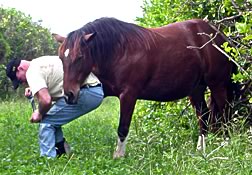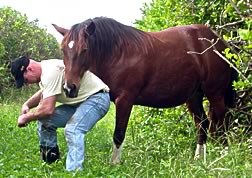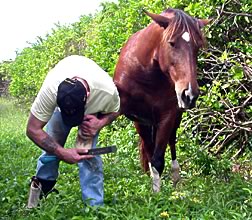|
|
|
|
 |
|
|
|
First Hoof Care Clinic Treats Six Abaco Barbs
|
|
|
|
During the week of Dec. 16, 2002 we spent four days 'in the field' with KC LaPierre, a specialist in barefoot hoof care. KC was assisted by Robyn Lord.
Frank Bell, a Horse Whisperer who has helped us with the wild horses for the last two years, was also in the thick of things.
Anthony Bostiwck, President of the Friends of the Abaco Barbary Horse also spent time in the field, lent his apartment to KC and Robyn provided parking space for Frank's van and hosted some truly memorable meals for the team.
It was three days of almost non stop adventure.
Our first problem was finding the horses. For whatever reason (and I haven't found one yet) both the two main bands and the others decided, about two months ago, to pretty much disregard the pattern of movements they have followed for nearly two years although Altair's band still stayed quite close to pattern. They are roaming to all corners of the farm, have been found back in the forest on both sides of the farm (including marching up and down what will be the main road of the preserve) and in general have made themselves scarce. so we spent many hours just roaming the farm looking for the horses, with 'spotters' in the backs of pick ups looking up and down endless rows of trees. I'ts amazing just how often waving banana leaves look like waving manes
Once we found a band, we had to use the usual astonishing quantities of tranquilizer, and even that only worked on the horses with whom I've had the most contact, with one exception. According to KC, this is very characteristic of Paso Fino horses. Since ours predate Pasos and are the type of horse from which the Pasos were bred, we finally have a resason for why they are so resistant to normal drug dosages. In the breed, this dash, verve and zest is called 'Brio' and I can state that our horses have it, each and every one. Quantities of drug that would have rendered much larger thoroughbreds comatose were actually almost ignored by two of the mares.
|
|
|
|
On the first day out we were able to dart five mares and treat four. All had varying degrees of founder (severe hoof pathology brought on by over rich diet and soft terrain). While Frank, Alex and I concentrated on keeping the horses calm and soothed KC went to work with speed and skill that looked like dance at times. Robyn captured much of the action on video tape, and Anthony Bostwick watched closely. |
|
|
|
 |
|
|
|
On the next days we tried the more difficult horses. Two mares, Adhara and Deneb, practically ignored the tranquilizer. Oh, they got groggy, loweree their heads, allowed us to approach, but that was it. Adhara led us a sedate chase through a distant corner of the farm and into the forest. She would let us approach, I got the darts, but she just wouldn't allow any work on her feet. |
|
|
|
 |
|
|
|
A third mare, Alnitak, stayed right on the edge. Three of her feet were done and KC got about 90% of what he wanted to do on the last foot. Which is amazing since he was working in and under the orange trees, working some, letting Alnitak edge away, working some more. Hoof work is hard enough as it is as often the trimmer has an awful lot of horse leaning on him. In the case of Alnitak when she wasn't leaning she was pulling. Approach, lift, set up all had to be done over and over again, and each session was shorter as the tranquilizer faded away. |
|
|
|
 |
|
|
|
About two months ago the stallion Altair had an injury to his left eye. Alone I could do nothing. With this team, and possibly because of his condition slowing him down, the tranquilizer worked enough that KC got his two back feet done, sluiced out the eye with saline (he will most likely lose the eye) and got penicillin into him. The next day we saw him, head up and looking more like himself than he had in weeks. The weeping from the eye had stopped. And the day after that, after following the same pattern for two years, he and his entire band had changed tactics, disappeared. We never did manage to find them. |
|
|
|
 |
|
|
|
I suspect we've set precedent again. The wild mustangs of the US Southwest have had hoof work done, but the horses are driven into corrals, roped, thrown trussed up and trimmed. We refuse to use those methods with our horses. I think we've proved that with gentleness, help from tranquilizers and a caring attitude our horses at least can be done without any trauma at all. For the horses with whom I've not had contact we may need to do full knock outs, we'll wait for a vet to work with us. But even then we'll take every care to be gentle with them. According to KC, it's entirely possible that after doing each horse a few times it will become accustomed to the procedure. |
|
|
|
 |
|
|
|
For two pages of photos showing KC's analysis of the pathology that killed the mare Atria in 2001,
click here.
|
|
|
|
The Abaco Barbary horses have lucked out once again. Some wonderfully skilled, caring people have given generously of their time and talent to help the horses back on the road to normal health. Add that good measure of Brio and we've taken firm steps toward a solid future.
|
|
|
|
|
|
|
|
|
|
|
|
|
|
|
|
|
|
|
|
|
|
|
|
|